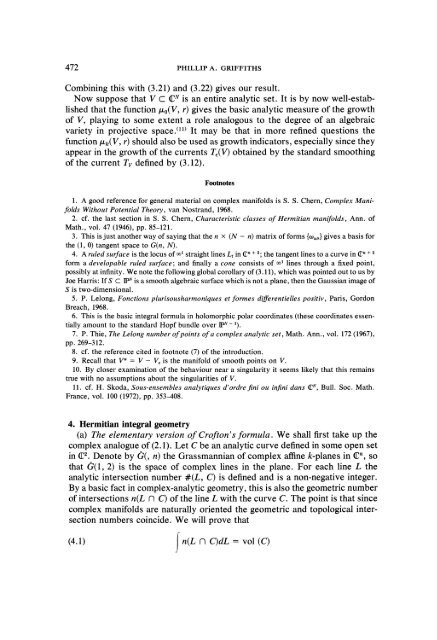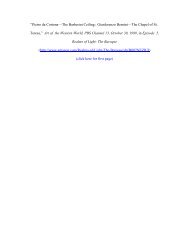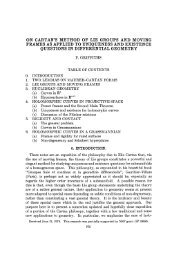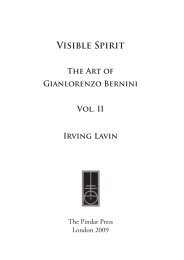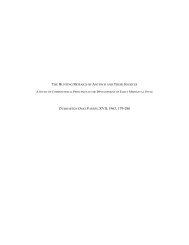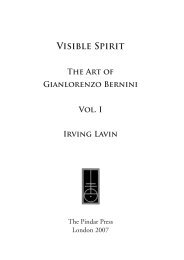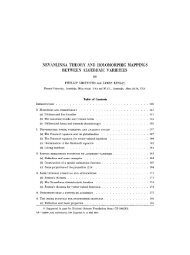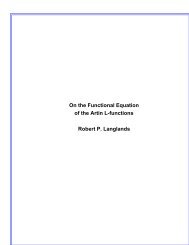View PDF - Project Euclid
View PDF - Project Euclid
View PDF - Project Euclid
Create successful ePaper yourself
Turn your PDF publications into a flip-book with our unique Google optimized e-Paper software.
472 PHILLIP A. GRIFFITHS<br />
Combining this with (3.21) and (3.22) gives our result.<br />
Now suppose that V C N is an entire analytic set. It is by now well-estabfished<br />
that the function/z0(V, r) gives the basic analytic measure of the growth<br />
of V, playing to some extent a role analogous to the degree of an algebraic<br />
variety in projective space. 11) It may be that in more refined questions the<br />
function k(V, r) should also be used as growth indicators, especially since they<br />
appear in the growth of the currents T,(V) obtained by the standard smoothing<br />
of the current Tv defined by (3.12).<br />
Footnotes<br />
1. A good reference for general material on complex manifolds is S. S. Chern, Complex Manifolds<br />
Without Potential Theory, van Nostrand, 1968.<br />
2. cf. the last section in S. S. Chern, Characteristic classes of Hermitian manifolds, Ann. of<br />
Math., vol. 47 (1946), pp. 85-121.<br />
3. This is just another way of saying that the n x (N n) matrix of forms {o,} gives a basis for<br />
the (1, 0) tangent space to G(n, N).<br />
4. A ruled surface is the locus of1 straight lines Lt in n / /<br />
2; the tangent lines to a curve in<br />
form a developable ruled surface; and finally a cone consists of 1 lines through a fixed point, "<br />
possibly at infinity. We note the following global corollary of (3.11), which was pointed out to us by<br />
Joe Harris: If S C IPN is a smooth algebraic surface which is not a plane, then the Gaussian image of<br />
S is two-dimensional.<br />
5. P. Lelong, Fonctions plurisousharmoniques et formes differentielles positiv, Paris, Gordon<br />
Breach, 1968.<br />
6. This is the basic integral formula in holomorphic polar coordinates (these coordinates essentially<br />
amount to the standard Hopf bundle over IPN- 1).<br />
7. P. Thie, The Lelong number ofpoints of a complex analytic set, Math. Ann., vol. 172 (1967),<br />
pp. 269-312.<br />
8. cf. the reference cited in footnote (7) of the introduction.<br />
9. Recall that V* V Vs is the manifold of smooth points on V.<br />
10. By closer examination of the behaviour near a singularity it seems likely that this remains<br />
true with no assumptions about the singularities of V.<br />
11. cf. H. Skoda, Sous-ensembles analytiques d’ordre fini ou infini dans (, Bull. Soc. Math.<br />
France, vol. 100 (1972), pp. 353-408.<br />
4. Hermitian integral geometry<br />
(a) The elementary version of Crofton’s formula. We shall first take up the<br />
complex analogue of (2.1). Let C be an analytic curve defined in some open set<br />
in 2. Denote by (, n) the Grassmannian of complex affine k-planes in n, so<br />
that (1, 2) is the space of complex lines in the plane. For each line L the<br />
analytic intersection number #(L, C) is defined and is a non-negative integer.<br />
By a basic fact in complex-analytic geometry, this is also the geometric number<br />
of intersections n(L fq C) of the line L with the curve C. The point is that since<br />
complex manifolds are naturally oriented the geometric and topological intersection<br />
numbers coincide. We will prove that<br />
(4.1) n(L f) C)dL vol (C)


